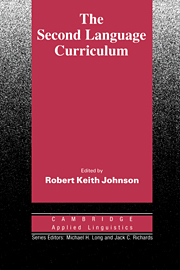Book contents
- Frontmatter
- Contents
- Contributors
- Series editors' preface
- Acknowledgements
- Overview
- I 1 CURRICULUM OVERVIEW
- I 2 CURRICULUM PLANNING
- II ENDS/MEANS SPECIFICATION
- Chapter 4 Needs assessment in language programming: from theory to practice
- Chapter 5 The role of needs analysis in adult ESL programme design
- Chapter 6 Service English programme design and opportunity cost
- III PROGRAMME IMPLEMENTATION
- IV CLASSROOM IMPLEMENTATION
- V EVALUATION
- Bibliography
- Index
Chapter 4 - Needs assessment in language programming: from theory to practice
Published online by Cambridge University Press: 05 October 2012
- Frontmatter
- Contents
- Contributors
- Series editors' preface
- Acknowledgements
- Overview
- I 1 CURRICULUM OVERVIEW
- I 2 CURRICULUM PLANNING
- II ENDS/MEANS SPECIFICATION
- Chapter 4 Needs assessment in language programming: from theory to practice
- Chapter 5 The role of needs analysis in adult ESL programme design
- Chapter 6 Service English programme design and opportunity cost
- III PROGRAMME IMPLEMENTATION
- IV CLASSROOM IMPLEMENTATION
- V EVALUATION
- Bibliography
- Index
Summary
Introduction
This paper is about how teachers and others involved in language programme planning can describe the language needs of prospective learners and about the tools they may employ to fashion their descriptions. It is also about the conceptual baggage planners inevitably bring to the planning situation – often unclarified beliefs and positions about learning and teaching which translate eventually into positions about learners' needs, needs assessment processes and syllabus design.
I want to examine the juncture between theory and practice in language needs assessment first by outlining what I think are some essential concepts in educational planning which do not ordinarily receive the credit they deserve for influencing the ways language programme planners undertake language needs assessment. Next I will try to relate general concepts and methodologies in educational needs assessment to our particular concern with needs assessment in applied linguistics. Finally, in my conclusion, I will try to isolate several key variables in the needs assessment process which planners in institutional situations will want to consider before they are overwhelmed by the forces of a large-scale language needs assessment. Throughout the discussion I will stress that language needs assessment is shaped by the local work environment and especially by the commonsense thinking of practising teachers about their work.
Ultimately my goal is to move beyond the aspects of methodology which ordinarily dominate needs assessments and to suggest what factors – largely subjective in nature – influence the interpretation and use of data during the assessment process.
- Type
- Chapter
- Information
- The Second Language Curriculum , pp. 48 - 62Publisher: Cambridge University PressPrint publication year: 1989
- 52
- Cited by

